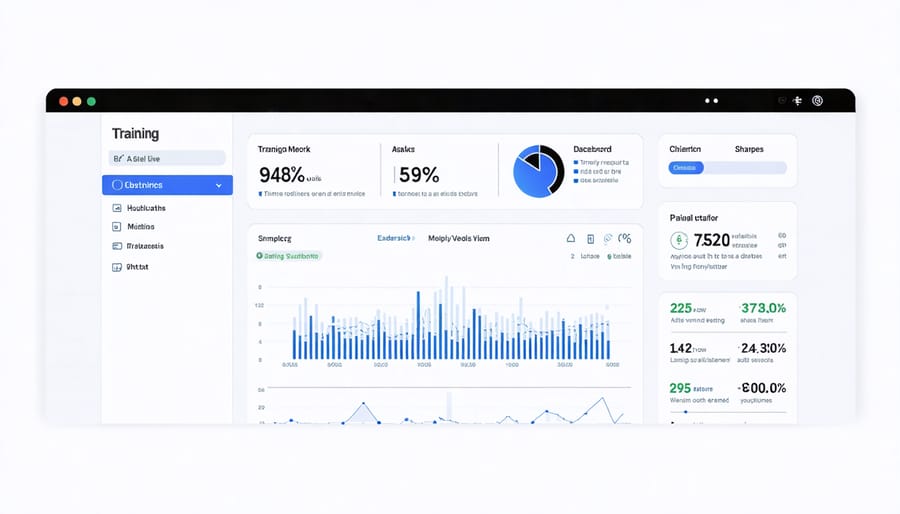
Transform your corporate training landscape with today’s innovative learning technologies that seamlessly blend accessibility with engagement. Gone are the days of mundane PowerPoint presentations and lengthy classroom sessions – modern training platforms now harness the power of artificial intelligence, virtual reality, and microlearning to deliver personalized, impactful experiences that stick.
Picture this: your team members completing bite-sized training modules during their morning coffee, participating in immersive VR simulations to practice complex procedures, or receiving AI-powered recommendations for their next skill development opportunity. This isn’t just future-gazing – it’s the reality of corporate training in 2024.
As someone who’s witnessed the evolution of workplace learning firsthand, I can tell you that the right training technology doesn’t just improve knowledge retention – it transforms the entire learning culture of an organization. Whether you’re a growing startup or an established enterprise, embracing these digital solutions can reduce training costs by up to 50% while boosting engagement rates and measurable outcomes.
The best part? You don’t need to be a tech wizard to implement these solutions. Today’s platforms are designed with user experience in mind, making the transition from traditional training methods smoother than ever.

Why Traditional Training Methods Are Falling Short
The Cost of Outdated Training Methods
Let’s be honest – we’ve all been there. Sitting in a stuffy conference room, struggling to stay awake during yet another PowerPoint presentation, while secretly checking our phones under the table. Traditional training methods aren’t just boring; they’re actually costing companies more than they might realize.
Studies show that businesses lose an average of $13.5 million per year for every 1,000 employees due to ineffective training. But the real cost goes beyond dollars and cents. When employees disengage during training sessions, they retain only about 10% of the information presented through conventional methods.
Think about Maria from accounting, who had to reschedule client meetings to attend a mandatory training session, only to forget most of what was covered by the next week. Or consider the environmental impact of printing thousands of training manuals that end up collecting dust on office shelves.
Add to this the hidden costs of travel expenses for in-person training, venue rentals, and instructor fees, and it becomes clear why outdated training methods are no longer sustainable in our modern workplace. The good news? There are better ways to invest in our teams’ growth that won’t break the bank or put everyone to sleep.
The Modern Employee’s Learning Needs
Today’s employees are reshaping how workplace learning happens, and it’s fascinating to see the shift! Gone are the days of lengthy PowerPoint presentations and rigid classroom sessions. Modern workers prefer bite-sized, flexible learning experiences that fit seamlessly into their busy schedules.
As someone who’s experienced both traditional and modern training approaches, I’ve noticed how my colleagues and I gravitate toward engaging learning methods that allow us to learn at our own pace. We want instant access to knowledge when we need it, whether that’s through mobile apps, short video tutorials, or interactive modules.
The modern employee values personalization and relevance above all else. We’re looking for training that directly applies to our daily tasks and career goals. Think of it like creating your own learning playlist – you want content that speaks to your specific needs and interests.
Social learning has also become increasingly important. We love sharing experiences with peers, participating in group discussions, and learning from real-world scenarios. It’s about building a community of learners who support and inspire each other while developing new skills.
Game-Changing Tech Solutions for Corporate Training
Virtual Reality Training Environments
Remember those childhood dreams of stepping into your favorite storybook? That’s exactly what Virtual Reality (VR) training feels like, except it’s helping professionals master real-world skills in a safe, controlled environment. As someone who recently experienced VR training firsthand, I can tell you it’s both thrilling and effective!
VR technology transforms traditional corporate training by creating interactive learning experiences that feel incredibly real. Imagine practicing a complicated medical procedure, conducting a sensitive HR conversation, or managing a crisis situation – all without real-world consequences. It’s like having a practice run before the big show!
What makes VR training so special is its ability to engage multiple senses. You’re not just watching or listening; you’re moving, speaking, and interacting with your virtual environment. This multi-sensory approach helps information stick better in your memory and builds muscle memory for physical tasks.
The best part? VR training adapts to each learner’s pace and style. Made a mistake? Simply reset and try again. Need more practice with a specific scenario? No problem! This personalized approach helps build confidence gradually, making the transition to real-world situations much smoother.
While implementing VR training might seem daunting at first, many companies are finding it more cost-effective than traditional training methods in the long run, especially for high-risk or complex scenarios.

Mobile Learning Platforms
Remember when we had to be glued to our desks for training sessions? Those days are long gone! As someone who’s always on the move between meetings and client visits, I’ve seen firsthand how mobile learning platforms have transformed corporate training into something that fits seamlessly into our busy lives.
Think of mobile learning platforms as your personal pocket mentor. Whether you’re waiting for your morning coffee or commuting on the train, you can squeeze in bite-sized lessons that actually stick. These platforms are absolutely brilliant for teams spread across different locations or those who prefer learning at their own pace.
One of the biggest wins I’ve noticed is how these platforms keep everyone engaged. With features like quick quizzes, interactive videos, and progress tracking, learning feels more like playing your favorite mobile game than sitting through a traditional training session. Plus, the flexibility to switch between devices means you can start a module on your phone during lunch and finish it on your tablet at home.
What really makes mobile learning shine is its ability to deliver just-in-time training. Need a quick refresher on presentation skills five minutes before your big meeting? It’s right there at your fingertips. The convenience factor is unbeatable, and studies show that this accessibility leads to higher completion rates and better knowledge retention.
AI-Powered Personalized Learning
Remember when one-size-fits-all training meant sitting through hours of content that might not even apply to your role? Those days are thankfully behind us! AI-powered personalized learning is revolutionizing corporate training in ways that feel almost magical.
Think of AI as your personal training concierge, constantly analyzing your learning style, pace, and preferences. Just like how your favorite streaming service suggests shows you might enjoy, AI-powered training platforms create custom learning paths tailored specifically to you. For instance, if you’re a visual learner who retains information better through videos, the system will automatically adjust to provide more video content.
What makes this technology truly special is its ability to adapt in real-time. Struggling with a particular concept? The AI will notice and offer additional explanations or practice exercises. Breezing through certain modules? It’ll increase the difficulty level to keep you engaged and challenged. It’s like having a mentor who knows exactly what you need, when you need it.
The best part? This personalization extends beyond just content delivery. AI can identify skill gaps in your team, suggest relevant training materials, and even predict which areas might need attention before they become challenges. It’s like having a crystal ball for professional development, helping everyone reach their full potential in a way that feels natural and engaging.
Implementing New Training Tech Successfully
Getting Team Buy-In
Let me share a story from my experience working with corporate teams: change can be challenging, but with the right approach, it can also be exciting! The key to successfully implementing new training technology lies in making your team feel like they’re part of the journey, not just passengers along for the ride.
Start by involving team members early in the decision-making process. When people feel their voice matters, they’re more likely to embrace change. Create focus groups where employees can test different training platforms and provide feedback. Their insights are invaluable and will help you choose solutions that truly meet their needs.
Following successful business implementation strategies, communicate the benefits clearly. Instead of focusing solely on company gains, highlight how the new technology will make their work lives easier. Will it save them time? Make learning more flexible? Let them access training materials on their phones? These personal benefits can be powerful motivators.
Consider appointing “training champions” within different departments. These enthusiastic early adopters can help demonstrate the value of new tools to their peers and provide support during the transition. They’re your allies in creating a positive buzz around the change.
Make the transition fun! Organize friendly competitions or challenges that encourage people to explore the new platform. Consider offering small rewards for completing certain training milestones or for helping colleagues navigate the new system.
Remember to celebrate small wins and share success stories. When team members see their colleagues succeeding with the new technology, it builds confidence and motivation across the organization. Keep the lines of communication open, and be ready to adjust your approach based on feedback.
Measuring Training Success
Have you ever wondered if your corporate training efforts are actually making a difference? Trust me, you’re not alone! The good news is that modern training technology makes measuring success metrics easier and more insightful than ever before.
Let’s start with the basics: completion rates and assessment scores. But here’s the thing – we’re going beyond just tracking who finished the course! Today’s learning platforms offer detailed analytics that show how employees interact with content, where they struggle, and which topics resonate most.
One of my favorite features is real-time feedback collection. Through quick polls and surveys integrated into training modules, you can gather immediate insights about what’s working and what needs improvement. It’s like having a conversation with every learner!
The real game-changer? Learning analytics that track behavioral changes. For example, if you’ve implemented sales training, you can correlate it with actual sales performance data. Or for compliance training, monitor incident reports before and after the program.
Here’s a practical tip I learned from my experience: focus on measuring both short-term and long-term impacts. While quick knowledge checks are important, the true measure of success lies in how well employees apply what they’ve learned months later.
Remember to celebrate small wins too! When employees see their progress tracked and acknowledged, it creates a positive learning culture that encourages continuous improvement. After all, what gets measured gets managed – and what gets celebrated gets repeated!

As we’ve explored throughout this article, embracing modern corporate training technology isn’t just about keeping up with trends – it’s about creating a more engaged, skilled, and confident workforce. The digital transformation of training has opened doors to possibilities we couldn’t have imagined just a few years ago, from immersive VR experiences to AI-powered personalized learning paths.
I’ve seen firsthand how companies that take the leap into modern training solutions often find their teams more connected, motivated, and better equipped to handle today’s fast-paced business environment. Whether you’re starting with simple video-based modules or diving into comprehensive learning management systems, every step toward modernizing your training approach is an investment in your organization’s future.
Remember, the key to successful implementation isn’t about adopting every new technology available – it’s about finding the right mix of tools that align with your team’s needs and your company’s goals. Start small if needed, gather feedback from your employees, and gradually build a training ecosystem that works for everyone.
The future of corporate training is here, and it’s more accessible than ever before. By taking action today to modernize your training programs, you’re not just improving skills and knowledge retention – you’re creating a culture of continuous learning that will drive your organization forward for years to come.



